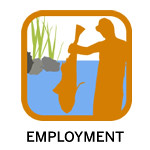Rob Diaz de Villegas Producer/ Editor WFSU-TV
When a lot of us think about science, we think about the laboratory. The lab: a sterile, controlled environment in which men and women in clean white lab coats toil with beakers and bunsen burners. The word science has a cleanliness to it. It sounds like tidy explanations, an orderly universe.
But, much like the universe is not always a tidy place, scientific knowledge isn’t always gained in a tidy manner. The studies that we will feature in this blog are conducted mostly in wet, muddy places. Dr. Randall Hughes studies salt marshes located in and around St. Joseph Bay. Getting to some of these places requires walking through water, and mud that you can sink in up to your knee and possibly lose your shoe in. Some of her sites are only accessible by kayak.
Read more about Randall’s research
The oyster reefs being studied by Dr. David Kimbro are in similar locations, right alongside salt marshes. But whereas Randall is a year into her study, and knows her sites and how to get to them, David is just starting to identify his sites and their challenges. We were able to go out with David on the first day of his study. He was just getting to know this one site on Alligator Harbor. Getting to the reefs involved walking from salt marsh island to salt marsh island in waist high water and deep, soft mud. The reefs themselves are of course covered in sharp shells, so you don’t necessarily want to fall down there like I did in the mud. It was a slow approach to the sites, and when we saw lightning not too far off, we had to make a fast getaway. Back at the lab later on, David decided that perhaps that site was best approached by boat.
We’ll have video of that first day with David up by next week. First we’ll have a video on Randall’s study. We’ll try to have at least one video a week, and the researchers will contribute posts. It will be a unique way to glimpse scientific study in action. And if what we’ve all been fearing happens, it will also serve as a record of how these habitats will survive crude oil washing up on to them. Both David and Randall have been collecting data on these healthy habitats in preparation for what may come.
But while we’ll be keeping an eye on that blob in the Gulf, we don’t really know what will happen. Until then, I’ll just enjoy my time in the mud and the water and try to post some informative videos, and try not to ruin too many socks.


1 comment
[…] David Kimbro and saw this dry erase board on his wall. For some reason, it made me think of the first post I wrote for this blog. In that post, and in a good majority of our posts and videos since, we showed and talked about […]
Comments are closed.